Posted by Elena del Valle on July 13, 2009

Martin Cerda, director, Encuesta Research
Photo, video: Encuesta, Inc.
Encuesta, Inc., a Miami research company, just released a 30-second thank you video in appreciation to past participants in its surveys and to celebrate its 20 anniversary in the business. The short video ad, in English and Spanish, was released initially on YouTube and is due to air on broadcast television in Los Angeles, New York, Miami, and Houston and on Azteca America, PBS, V-me, and GenTV.
The video was produced in-house with a limited budget and included the contribution of an illustrator, Ken Orvidas, a voice over artist and an animator who asked to remain anonymous. The inspiration, in part, for the work was a painting from a social club in a small town in Spain.Scroll down to watch the videos in English and Spanish.
“We want to thank Hispanics nationwide for allowing us the privilege to enter their lives on a daily basis, all in an effort to have one person’s opinion represent that of thousands of members of their community” said Martin G. Cerda, founder and president of Encuesta, Inc. “Latino participation in the survey research process helps advance public understanding of social and economic issues and helps influence government and corporate decision makers.”
Founded in 1989, Encuesta, Inc. is a U.S. Hispanic market research and public opinion polling company that offers quantitative and online qualitative research designs and analysis. Encuesta, Inc. is the company behind the Americanos Poll, a public opinion poll created in 2005 to help bridge the knowledge gap that exists regarding the U.S. Hispanic community.
Click on the first screen for the English language video and on the second screen for the Spanish language video.
Posted by Elena del Valle on July 8, 2009

Kim L. Hunter, founder, Lagrant Foundation
Photo: Lagrant Foundation
Since its founding in 1998, Los Angeles based The Lagrant Foundation has distributed a little less than $1 million worth of scholarships to 150 students. It has placed 120 interns at advertising and public relations agencies and corporations nationwide, and produced 40 career development workshops. This year, there were six Latino, seven African American and two Asian/Pacific Islander applicants.
Each year the organization awards 15 scholarships; to date ten $5,000-scholarships have been awarded to undergraduate students and five $10,000 scholarships have been awarded to graduate students. Its funding sources are corporations, agencies, individual donors and grants from corporations. Major donors include American Express, Edison International and Weber Shandwick Worldwide.
“For more than ten years now, the foundation has been committed to fulfilling its mission of funding dreams into reality and furthering the advancement of ethnic minorities within the fields of advertising, marketing and public relations,” said Kim L. Hunter, founder and chairman, The Lagrant Foundation. “The recipients reflect the future of this industry and will continue to academically excel toward a successful career path.”
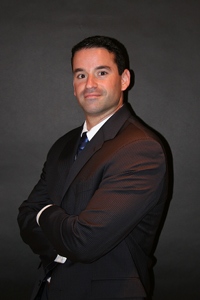
Erick Laseca, scholarship recipient and graduate student
“Thanks to The Lagrant Foundation’s generous scholarship, I was able to stop working and transfer to full-time status at school. This gave me the opportunity to apply for Northwestern’s summer residency program, where I was chosen to work with award-winning faculty for a globally-recognized brand from a major consumer packaged goods company,” said Erick Laseca, a scholarship recipient and full-time grad student at Northwestern University studying integrated marketing with an emphasis on marketing analytics. He serves on the student advisory council, the committee for the study abroad program as well as the boards for the American Red Cross and the Chicago International Film Festival.
“Beyond the monetary contribution to my education, The Lagrant Foundation provided tremendous networking opportunities with senior leaders from top corporations and agencies, with whom I’ve connected and have promising employment prospects upon graduation and ongoing relationships in the marketing industry.”
To qualify for Lagrant scholarship monies applicants must be African American, Hispanic/Latino, Asian Pacific Islander or Native American pursuing an undergraduate or graduate degree in advertising, marketing or public relations at an accredited four-year university or college. Scholarship judges look for promising students who demonstrate a passion in public relations, advertising or marketing and a desire to pursue a career in one of those fields.

Christine E. Nieves, scholarship recipient
“The Lagrant Foundation has been an example of an organization established to contribute to the solution of a threat challenging the progressive development and growth of the Marketing, Public Relations and Advertising Industry. More than a scholarship, TLF provides the opportunity for underrepresented minority students to comprehend the challenges faced by professionals and to a witness their responses by way of comprehensive workshops sparked with an academic approach,” said Christine E. Nieves, a senior at University of Pennsylvania with a major in Communication and Public Service, and a minor in Consumer Psychology.
“Throughout the three years I have been a Lagrant scholar, I have come to realize that no other organization can merge the wealth of knowledge, the diversity of talent, and the breath of executives at the caliber TLF has achieved; the highlight being the sincere interest demonstrated by the members of the board and Kim Hunter to help each of us succeed in our career.”
The 2009 Final Judges include Micheline Amy, vice president,Constituency Management Group; Alvaro Cifuentes, programs manager, Diversity Agency Services; Jennifer Cohan, managing director, Golin Harris; Hiroko Hatanaka, vice president, IW Group, Inc.; David P. Henry, president, Telenoticias; Andrea Hoffman, president and CEO, Diversity Affluence; Julia Hood, publishing director, PR Week; Lisa F. Hyden Carrieri, managing director, Ogilvy Public Relations Worldwide; Penny Mitchell, senior partner, Fleishman-Hillard; Claudine P. Moore, director, Hill & Knowlton, Inc.; Dana Muldrow, manager, Deloitte; Michael J. O’Neill, senior vice president, American Express Company; Dave Ramirez, copywriter, McCann-Erickson; Kelly Ramirez, vice president, Euro RSCG Worldwide; William Murray, president and COO, Public Relations Society of America; Andrew Sawyer, executive vice president, Alloy Media Services; and Tiffany R. Warren, chief diversity officer, Omnicom Group, Inc.
The non profit organization relies on volunteers and two staff members, Ericka Avila, a programs manager, and Joy Hunter, the executive director. Kim L. Hunter (no relation to Joy) is the founder and chairman of The Lafgrant Foundation. They concentrate their outreach efforts on California, New York, Texas, Illinois and Florida, states with many ethnic minority students.
Posted by Elena del Valle on July 1, 2009
By Vanessa Bravo
Intern, HispanicMPR.com
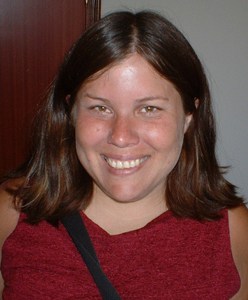
Vanessa Bravo
The three sections users prefer are guest articles, articles authored by Elena del Valle and podcasts
Happy birthday! Hispanic Marketing and Public Relations (HispanicMPR.com) is reaching its fourth anniversary and is growing fast. What started four years ago as a small forum to share ideas about the book Hispanic Marketing & Public Relations (Poyeen Publishing, $49.95) has grown into a fully developed website with a wealth of information about business topics in general and the Hispanic market in particular.
Today, HispanicMPR.com offers visitors dozens of guest articles, podcasts, articles authored by Elena del Valle (host and editor of the website), presentations, videos, and job ads. The website has become a useful tool for business people and entrepreneurs interested in topics like marketing, public relations and business development. It has grown a loyal pool of users: just the e-mail newsletter is received by more than 3,500 subscribers.
Click here to read the complete article
Posted by Elena del Valle on June 29, 2009
Graphics: HispanicMPR, Vertis
For several years the media industry has been changing before our eyes. Slowly we witness a media revolution and evolution driven by outdated business models, the increasing availability of technology to an ever growing populace and consumers’ mistrust of conventional media as well as the desire of some consumers to be part of the machinery that informs and opines.
As one of the latest large waves of immigrants Latinos are a significant consumer market for media because the Hispanic market is young, comparatively speaking, and growing. The most recent arrivals often have their own cultural preferences for media consumption and may even prefer Spanish language or bilingual options. Many among the millions of Latino immigrants or children of immigrants, usually the most affluent and best educated, have acculturated and mimic mainstream consumers in their media consumption habits.
Some data, including a Vertis Communications 2007 telephone survey of 500 Hispanic adults, indicates Latinos may spend more time watching television and surfing the web than their counterparts among established and emerging markets. Respondents to that survey also were 44 percent more likely to be influenced by information they found online than the total United States population.
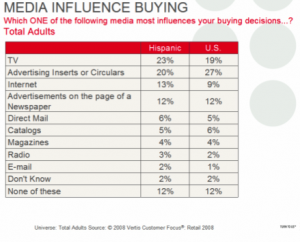
Although they may make many of their purchases offline they are likely to research choices, reviews and prices online before placing an order by phone or shopping in person. Vertis researchers concluded that Hispanic adult respondents were more likely than the overall population to buy consumer electronics, even when the economy was down. For example, 28 percent of Hispanics said they would buy a big screen or HDTV within 12 months while only 23 percent of non-Hispanics anticipated such purchases.
The survey also found that Hispanics with online access conducted the most internet research on electronics and clothing. At that time, 62 percent of Hispanics with internet access said they researched home electronics online prior to purchase compared to 59 percent of all United States respondents with internet access. Also, 38 of online Hispanics who participated in the survey said that they research clothes online before buying them compared to 30 percent of all online respondents.
The Vertis Customer Focus Opiniones survey is designed to track consumer behavior in retail, grocery, home improvement, fashion, home electronics, sporting goods, furniture, technology, auto aftermarket, financial and media such as direct mail marketing. The 2007 Opiniones survey conducted by Vertis was the most recent survey of that type conducted by the company, according to a company spokesperson.
Posted by Elena del Valle on June 24, 2009
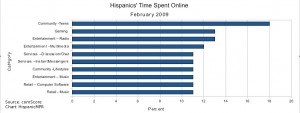
Hispanics
For companies targeting online audiences Latinos represent a booming market with continued potential for growth. As of February 2009 there were 20.3 million Hispanics or 11 percent of the total United States online population and a record number, according to comScore, Inc., a company that measures the digital world. As a greater number of Hispanics went online in the past year, the U.S Hispanic Internet audience grew faster than the total U.S. online population in terms of number of visitors, time spent and pages consumed.
At the same time, some believe effective targeting of the Latino online market requires knowledge and finesse to push the hot buttons that will prompt loyalty and purchasing responses from the highly diverse and demographically young audience. The days of viewing ethnic markets through a uni dimensional single scope are past. Just as translating materials as the sole method of addressing the highly desirable Hispanic market, online and offline, is no longer considered sufficient or in some cases even appropriate (when targeting English dominant Latinos for example).
“It’s well known that the Hispanic market is a growing and increasingly important segment to advertisers and marketers,” said Jack Flanagan, executive vice president of comScore Media Metrix. “However, any business attempting to effectively reach this segment needs to understand the behavior of the U.S. Hispanic online consumer as a fundamental component of their marketing and media strategies.”
Some are convinced the Hispanic market is diverse and distinct from the general market. Given the increasing number of new Latin consumers and their desirable purchasing habits even if that market segment requires extra attention, dedicated or customized campaigns it may prove a worthwhile investment for savvy businesses in the long term.
“As most people know, US-H (US Hispanics) currently represents 15 percent of the total US population and it is estimated to grow up to 20 percent within the next 10 years, half of them are online and this number will only grow. The fact is that even thought we are still a minority, we are definitely a minority that can not be underestimated, not only because of the massive number of potential costumers that we represent, but because our habits significantly differ from those of the US General market users, and more importantly, because our purchase behavior is way more apealing than the US General market users,” said Joel Bary, chief executive officer, Latin Medios.
“We, the online Latinos, have a higher household income than any other online users group in the US, and simply put, we buy more than any other group, so we make a very interesting and potential costumer base that can not be ignored. The marketplace is no longer a single group one, it is now composed of several major groups that will need to be addressed in a special and direct way, other ways, a segment of this marketplace will not respond to the message and will be left araw to be picked up by the competition.”
In 2009, Hispanics’ time online increased 6.9 percent (3.9 times faster than the total U.S. online population), while total pages consumed grew 6 percent (3.6 times faster than the total U.S. Population).
“The Hispanic online market is growing faster than the general market, not just in terms of gross number of users but also in other measures that are important to marketers like time spent online. Advertisers are taking notice too: While categories like Automotive, Wireless, and Credit Cards have been on board since the early days of Hispanic internet, more recently we’ve noticed growth coming from other important categories like Food, Retail, Insurance, and Personal Care Products. That’s especially important now that the automotive and credit card categories are down,” said Carlos Pelay, president, Media Economics Group.
“Just in the Food category, for example, we’ve seen some major companies making their first forays into the Hispanic online market in 2009. Companies like Birds Eye Foods (BirdsEyeenEspanol.com), General Mills (“Nature Valley”), Hershey (“Hershey’s Kisses” sweepstakes on Univision.com) have advertised on Hispanic sites for the first time this year. Significantly, these three companies are running Spanish-language campaigns on Spanish-language Hispanic websites.”
Researchers looked at the site categories where Hispanics spent an above average share of their online time. The most popular categories were Community – Teens, where U.S. Hispanics accounted for 18 percent of total time spent in the category; Gaming Information at 13 percent; entertainment and leisure including Radio (13 percent), Multimedia (12 percent), Discussion/Chat, Instant Messengers (11 percent) and Music (11 percent).
Reach Hispanics online today with
“Marketing to Hispanics Online” audio recording
Identifying and characterizing the booming Hispanic online market


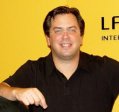
Joel Bary, Alex Carvallo and Matias Perel
Find out about
• The 16 million Latino online users
• Latino online users by gender
• What they do online
• Their language preferences
• How to reach Hispanic urban youth online
• What affects their online behavior
• What influences their purchases
Click here for information about “Marketing to Hispanics Online”
Posted by Elena del Valle on June 17, 2009

Sticky buns prepared at home
Photo: Simon and Baker
In the last two years sugar consumption has increased 20 percent. This is important because sugar is the most popular product in the $4.3 billion sweetener industry in the United States. The industry is divided into three main segments: sugar, sugar substitutes, and liquid sweeteners for tabletop use and as ingredients in baking. There are also presweetened products competing for space in supermarket shopping carts. Ultimately it’s the buyer who decides whether to opt for sugar-based, presweetened or sugar-free products.
While most American households, 89 percent, use sugar, 48 percent of households rely on sugar substitutes. At the same time, while sugar is equally popular across most demographic groups older adults favor sugar substitutes
It is interesting to note that in spite of the popularity of sugar, those consumers have the lowest brand loyalty. Some 47 percent of homes that bought granulated sugar picked the store brand; 39 percent of homes bought Domino, and 26 percent chose C & H, according to a recent study conducted by Mintel, a supplier of consumer, media and market research. A Mintel spokesperson responded by email that demographic breakdown by gender, age, ethnic group or geographic location was available.
In 2008, consumers used an average of 2.4 pounds of sugar each month compared to 2 pounds in 2006. Households using sugar substitutes consumed an average of three packets per day, and 60 percent of them selected Splenda.
On the other hand, users of sugar substitutes are brand loyal and prefer substitutes to sugar because of the calorie savings. One third of sugar substitute consumers like the products because of the way they dissolve and 27 percent believe they are better for dental health. Consumers of liquid sweeteners like honey, molasses, and pancake syrup are also brand loyal.
Economic climate changes have driven consumers to dine at home more often, resulting in an increase in consumption of sugar and sugar like products. Changes in sugar markets such as the use of sugar for biofuel, man made and natural disasters that impact the industry may affect availability and prices. At the same time, the sugar substitute market has seen promising developments thanks to the availability of natural sugar free sweeteners like stevia and agave.
Health related issues affecting America’s aging population, especially obesity and diabetes, also impact the consumption and selection of sugar industry products. Obesity and diabetes are exacerbated by excessive sugar consumption, driving sufferers to purchase sugar substitutes instead of sugar. Older consumers are most likely to have these conditions which is why they are more inclined than younger consumers to purchase sugar substitutes.
Posted by Elena del Valle on June 15, 2009
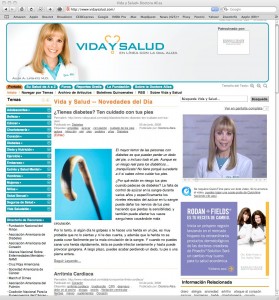
VidaySalud.com homepage
Photos: VidaySalud.com
In early June, Aliza Lifshitz, M.D., known to some Spanish speakers in the United States as la Doctora Aliza, launched VidaySalud.com, a Spanish-language health oriented website. About 20 percent of the content of the website, the Salud de A a Z section, is Spanish language translations from Harvard Health Publications. The remaining 80 percent is original content.
Editor Ana María Hanssen is responsible, with the help of five contributors, Carolina Dueñas, Natalia Jaramillo, Vanina Lombardi, Adriana Lozada and Francisco Stohr, for the editorial content of the portal. The publisher, Carl J. Kravetz, expects that over time the percent of original content will increase as daily articles are added to the website.
Kravetz, Lifshitz’ husband, also serves as the new website’s executive director. The two of them own the portal and portal copyrights are reserved to Cultural Asset Management Inc. The target audience is Latino mothers who are commonly considered the keepers of the health in Hispanic families. So far 60 percent of the registrations on the new website are from women. Sign ups have arrived from the United States as well as every country in Latin America and Spain.
“VidaySalud.com(TM) is the largest source of health information and wellness tools in Spanish on the web. It includes Health A to Z, the Harvard Medical School’s searchable database of symptoms, diseases and treatments, as well as original content, updated daily and created especially with the U.S. Hispanic community in mind,” said Lifshitz. “Our goal is to enhance the relationships between Latino patients and their physicians by giving Hispanics the information, tools and skills they need to better communicate with their doctors, to ensure better compliance with physician instructions and to deliver better health outcomes.”
VidaySalud.com includes channels on kids’, teens’, men’s and women’s health, diet and nutrition, exercise, pregnancy, diabetes, heart health, cancer, stress and mental health, sexual health, health insurance, health and beauty and healthy living. There is also a section on Quackery to inform users about how to protect themselves from unscrupulous promoters of unproven cures, remedies, diets and nutritional supplements. Eleven biweekly email newsletters on a variety of health topics are available through free registration.
“No one is more trusted on health by the Latino community than la Doctora Aliza,” said Kravetz. “With her as editor in chief and with science-based content delivered in the warm, caring style she is known for, VidaySalud.com will be an invaluable resource for Latino families.”
Promotion of the portal, including an active public relations program, will be focused on the site’s main target audience, Spanish speakers living in the United States. The company plans to announce joint initiatives with Ser Padres, People en Español, impreMedia and Univision. Doctora Aliza blogs’ on AOL Latino and Univision Radio link to the new website. The portal has co-branded its Niños (children) and Embarazo (pregnancy) pages with Ser Padres and the two publications will promote them together.
There are also plans for periodic health campaigns in partnership with the traditional media that Dra. Aliza works with. Her articles in impreMedia, People en Español and Ser Padres refer readers to the site. In addition, a partnership for the portal to become a resource for doctors and their Latino patients is in the works.

Aliza Lifshitz, M.D.
Lifshitz, a physician, author and health reporter, is involved with the Univision television network’s Peabody Award-winning health initiative Enterate: Salud es Vida. She also appears on the network’s Primer Impacto program. Her live call-in program, El Consultorio de la Dra. Aliza, airs weekly on the Univision Radio network.
She writes regular monthly columns for People en Espanol and for Ser Padres, and her weekly column is syndicated in Spanish-language newspapers nationwide. Her monthly column in the Vista bilingual supplement runs in 29 newspapers nationwide. In addition to her activities in the media, Dr. Lifshitz maintains a full-time private practice in internal medicine at Cedars-Sinai Medical Center in Los Angeles.
“Latino Family Dynamics” audio recording


Brenda Hurley and Liria Barbosa
Discuss
- Latino purchasing habits and products they favor
- Latino family characteristics
- Latinos and extended families
- Division of duties, responsibilities within the family
- Who is the decision maker in the Latino family
- Who is the information provider in the Latino family
Click here to find out about Latino purchasing habits and “Latino Family Dynamics”
Posted by Elena del Valle on June 10, 2009

Michael Zuccato, General Manager of Cuba Travel Services, Inc.
Photo: Cuba Travel Services
Cuba Travel Services, Inc., a Long Beach, California company owned by “a group of Los Angeles business people” will launch a non-stop weekly flight from Los Angeles to Havana, Cuba starting June 30, 2009. The inaugural flight is 50 percent sold as of this writing. Havana bound departures will be Tuesdays at 11 a.m. and returns to Los Angeles will be at 8:25 p.m. the same day.
The company will be utilizing aircraft operated by Continental Airlines with space for up to 150 passengers, 12 First Class and 138 Coach. The five-hour flights will cost $889 and include up to 60 pounds of Licensed Passenger Check Baggage. First Class tickets will cost $1,395.
“We are excited to resume the non-stop flights out of LAX to Havana that were in such high demand prior to the Bush Administration’s restrictions imposed on Cuban Americans that limited their ability to visit with their families in Cuba,” said Michael Zuccato, general manager of Cuba Travel Services, Inc.
Company executives expect the recent policy changes allowing easier travel to Cuba for Cuban Americans brought on by the Obama Administration will drive demand for travel to the island from the West Coast. Cuba Travel Services, Inc. also hopes to serve the travel needs of journalists, government officials and researchers that qualify under a general license; and sports teams, religious organizations, educational facilities and other organizations or individuals who qualify for and are issued a specific license to travel.
Cuba Travel Services, Inc. has been offering direct charter flights from Los Angeles to Havana since 2000. According to the data supplied by them, in 2003, the United States ranked eighth in visitors per country of origin to Cuba with 84,529 visitors; by 2005 only 37,233 travelers were visiting the island.
Cuba Travel Services Inc. was formed to “facilitate a better understanding between the U.S and Cuba” by providing flights to U.S. citizens who qualify under the current U.S. Treasury regulations. Cuba Travel Services Inc has offices in Doral and Hialeah, Florida and Hato Rey, Puerto Rico. The company has more than 20 employees.
“Latino Family Dynamics” audio recording


Brenda Hurley and Liria Barbosa
Discuss
- Latino purchasing habits and products they favor
- Latino family characteristics
- Latinos and extended families
- Division of duties, responsibilities within the family
- Who is the decision maker in the Latino family
- Who is the information provider in the Latino family
Click here to find out about Latino purchasing habits and “Latino Family Dynamics”
Posted by Elena del Valle on June 8, 2009
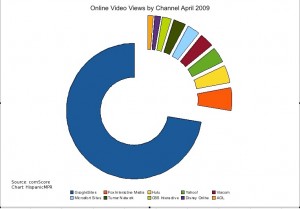
Videos Viewed Online April 2009 - click to enlarge
An epidemic is sweeping the country. No, not the flu. It’s videos. Online. Now that broadband Internet is widely available Americans seem to have fallen in love with videos. Although these are mostly short clips, 3.5 minutes on average, billions of videos were viewed around the country in the past months. In April 2009, for example, Americans viewed 16.8 billion videos online, including 6.8 billion videos viewed on Google. The average U.S. viewer watched 6.4 Hours video online that month, according to comScore Video Metrix. This represents a 16 percent increase compared to March 2009. ComScore analysts believe the increase was driven by a surge in viewing on YouTube.
YouTube.com accounted for more than 99 percent of all videos viewed at the property. Fox Interactive Media ranked second with 513 million videos (3.1 percent), followed by Hulu with 397 million (2.4 percent) and Yahoo! Sites with 355 million (2.1 percent).
In the United States, 152 million Internet users watched an average of 111 videos per viewer in April 2009. Google Sites reached an all-time high of 107.9 million video viewers during the month. Fox Interactive Media ranked second with 58.8 million viewers, followed by Yahoo! Sites (45.4 million) and Hulu (40.1 million).
ComScore researchers concluded that 78.6 percent of the U.S. Internet audience viewed videos online. A closer look reveals that 107.1 million viewers watched 6.8 billion videos on YouTube.com or about 63.5 videos per viewer; 49 million viewers watched 387 million videos on MySpace.com or 7.9 videos per viewer. Hulu accounted for 2.4 percent of videos viewed and 4.2 percent of all minutes of online video viewing.
A Virginia based company, comScore measures digital media usage. The company’s capabilities are based on a large international cross-section of 2 million Internet users who allow comScore to confidentially capture their browsing and transaction behavior, including online and offline purchasing.
“Moving Beyond Traditional Media Measurement: measuring conversations and social media” audio recording

Presenter Katie Delahaye Paine, founder, KDPaine & Partners
Find out about
- Issues affecting online public relationships today
- Testing relationships as part of a survey
- Measuring ethnic group relationships
- Measuring foreign language communications in a similar ways to English
- Biggest challenges measuring conversations and social media
- Measuring online relationships with little or no money
Click here for information on “Moving Beyond Traditional Media Measurement”
Posted by Elena del Valle on June 3, 2009

Would you like to be more creative? Try spending some time in another country. It seems living abroad might enhance your creativity. Really. Rudyard Kipling, Pablo Picasso, Ernest Hemingway, Paul Gauguin, and Samuel Beckett all did it and look at what happened to their careers. According to two psychologists relying on anecdotal evidence, experience living outside a person’s home country made them more likely to solve a creativity problem compared to colleagues who had not lived abroad.
According to an article in the Journal of Personality and Social Psychology, two researchers William Maddux of INSEAD, a business school in Fontainebleau, France, and Adam Galinsky, of the Kellogg School of Management in Chicago, gave 155 American business students and 55 foreign ones studying in America a creativity test. Each subject received a candle, some matches and a box of drawing pins, and was asked to attach the candle to a cardboard wall without allowing any wax to drip on the floor when the candle was lit.
Those who used the box as a candleholder and fixed it to the wall with the pins solved the problem. In the end, 60 percent of students who were either living abroad or had spent some time doing so solved the problem while only 42 percent of those who had not lived abroad did so.
They conducted another study in which 72 Americans and 36 foreigners tested their creative negotiating skills. As part of the exercise, students in pairs were assigned a negotiation in which each side was provided instructions that were contrary to an agreement. Seventy percent of the pairs of negotiators where both had lived outside their countries were able to reach an agreement. In contrast, when neither negotiator had lived abroad they were unable to reach a deal.
Could it be simply that creative people are more likely to choose to live abroad? To find out the researchers looked at traits like openness to new experiences, relying on statistical methods to eliminate the possibility that it was just creativity driving people to live abroad. In the end, they concluded that the experience of living abroad fostered creativity.
“Moving Beyond Traditional Media Measurement: measuring conversations and social media” audio recording

Presenter Katie Delahaye Paine, founder, KDPaine & Partners
Find out about
- Issues affecting online public relationships today
- Testing relationships as part of a survey
- Measuring ethnic group relationships
- Measuring foreign language communications in a similar ways to English
- Biggest challenges measuring conversations and social media
- Measuring online relationships with little or no money
Click here for information on “Moving Beyond Traditional Media Measurement”





























